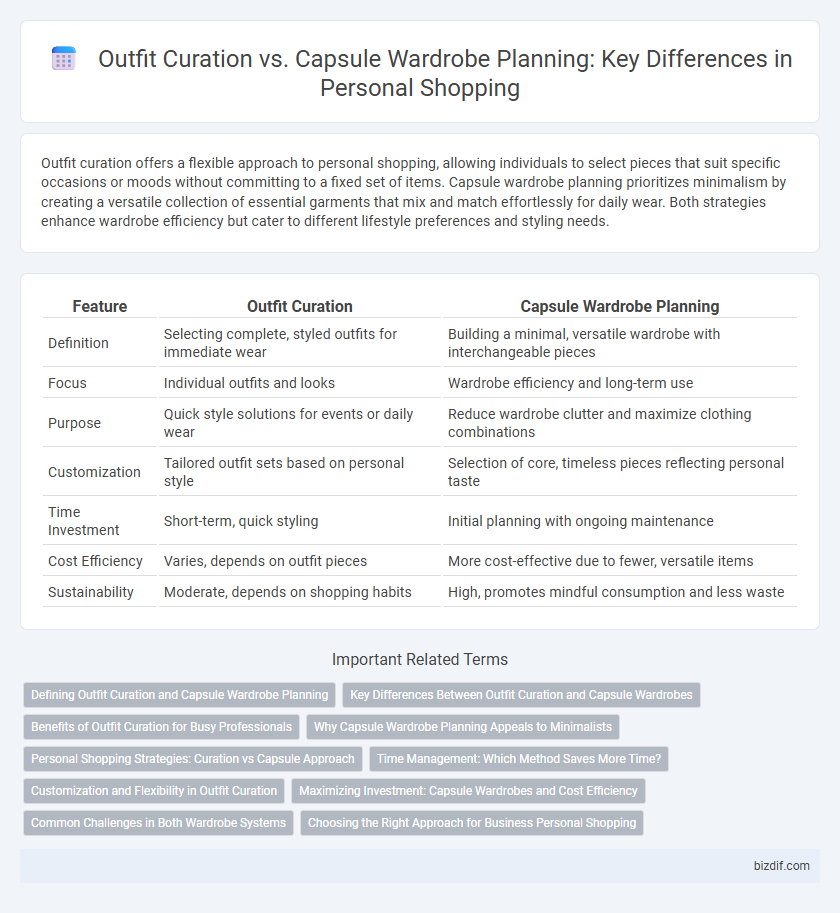Outfit curation offers a flexible approach to personal shopping, allowing individuals to select pieces that suit specific occasions or moods without committing to a fixed set of items. Capsule wardrobe planning prioritizes minimalism by creating a versatile collection of essential garments that mix and match effortlessly for daily wear. Both strategies enhance wardrobe efficiency but cater to different lifestyle preferences and styling needs.
Table of Comparison
| Feature | Outfit Curation | Capsule Wardrobe Planning |
|---|---|---|
| Definition | Selecting complete, styled outfits for immediate wear | Building a minimal, versatile wardrobe with interchangeable pieces |
| Focus | Individual outfits and looks | Wardrobe efficiency and long-term use |
| Purpose | Quick style solutions for events or daily wear | Reduce wardrobe clutter and maximize clothing combinations |
| Customization | Tailored outfit sets based on personal style | Selection of core, timeless pieces reflecting personal taste |
| Time Investment | Short-term, quick styling | Initial planning with ongoing maintenance |
| Cost Efficiency | Varies, depends on outfit pieces | More cost-effective due to fewer, versatile items |
| Sustainability | Moderate, depends on shopping habits | High, promotes mindful consumption and less waste |
Defining Outfit Curation and Capsule Wardrobe Planning
Outfit curation involves selecting individual garments and accessories to create specific looks tailored for various occasions, emphasizing style flexibility and personalization. Capsule wardrobe planning centers on building a minimal, cohesive collection of versatile pieces that mix and match easily, promoting simplicity and sustainability. Both strategies aim to enhance wardrobe functionality but differ in scope: outfit curation focuses on diversity and trend integration, while capsule planning prioritizes long-term practicality and reduced clutter.
Key Differences Between Outfit Curation and Capsule Wardrobes
Outfit curation emphasizes creating personalized, flexible looks by mixing and matching individual pieces tailored to current trends and personal style, while capsule wardrobe planning focuses on building a minimal, cohesive collection of versatile essentials designed for long-term use. Key differences include the level of intentionality in selection, with capsule wardrobes prioritizing sustainability and simplicity, contrasting with outfit curation's focus on variety and adaptability. Capsule wardrobes typically consist of 20-40 items optimized for seasonality and frequent rotation, whereas outfit curation allows for a broader, trend-driven assortment reflecting evolving fashion preferences.
Benefits of Outfit Curation for Busy Professionals
Outfit curation streamlines daily dressing for busy professionals by offering ready-to-wear combinations that save time and reduce decision fatigue. This approach maximizes wardrobe versatility through pre-selected pieces tailored to individual style and work requirements, enhancing confidence and professionalism. Unlike capsule wardrobes, outfit curation adapts dynamically to changing trends and occasions, providing greater flexibility and personalization.
Why Capsule Wardrobe Planning Appeals to Minimalists
Capsule wardrobe planning appeals to minimalists by emphasizing simplicity, versatility, and intentionality in clothing choices. It reduces decision fatigue by limiting the number of pieces to essential, high-quality items that mix and match effortlessly. This approach promotes sustainability and cost-effectiveness, aligning with minimalist values of mindful consumption and clutter-free living.
Personal Shopping Strategies: Curation vs Capsule Approach
Outfit curation emphasizes selecting versatile pieces tailored to current trends and individual style, maximizing daily wearability and fresh looks. Capsule wardrobe planning focuses on building a minimal, cohesive collection of timeless essentials to simplify dressing and reduce clutter. Personal shopping strategies balance these approaches by prioritizing functionality, style adaptability, and long-term wardrobe sustainability.
Time Management: Which Method Saves More Time?
Outfit curation allows for quick daily decisions by selecting pre-coordinated looks, reducing morning stress and saving time. Capsule wardrobe planning requires an upfront investment to create a limited, versatile closet that minimizes outfit choices long-term, streamlining daily outfit selection. Overall, capsule wardrobe planning offers greater time savings by simplifying daily decisions through strategic clothing selection.
Customization and Flexibility in Outfit Curation
Outfit curation emphasizes customization and flexibility by allowing individuals to select pieces tailored to their unique style, occasions, and changing trends. Unlike capsule wardrobe planning, which focuses on minimalism and long-term uniformity, outfit curation adapts daily to personal preferences and seasonal shifts. This approach enhances personal expression and ensures a versatile, dynamic wardrobe suited for varied lifestyle needs.
Maximizing Investment: Capsule Wardrobes and Cost Efficiency
Capsule wardrobe planning maximizes investment by focusing on a limited selection of versatile, high-quality pieces that can be mixed and matched, reducing overall clothing costs and waste. Outfit curation often involves a broader range of items, which can increase spending without guaranteeing frequent use. Prioritizing capsule wardrobes enhances cost efficiency by promoting thoughtful purchases and extending wardrobe longevity.
Common Challenges in Both Wardrobe Systems
Outfit curation and capsule wardrobe planning both face common challenges such as balancing versatility with personal style, managing limited clothing options for various occasions, and ensuring all pieces coordinate effectively to avoid wardrobe redundancy. Maintaining seasonal relevance and adapting to changing fashion trends also complicate the process, often leading to decision fatigue and underutilization of key items. Efficient decluttering and strategic item selection remain essential to overcoming these obstacles for a functional and cohesive wardrobe.
Choosing the Right Approach for Business Personal Shopping
Outfit curation offers a flexible, trend-driven approach ideal for clients seeking variety and seasonal updates, while capsule wardrobe planning emphasizes timeless, cohesive pieces that maximize versatility and minimize closet clutter. Business personal shoppers must evaluate client lifestyles, budgets, and style goals to determine which method enhances wardrobe functionality and satisfaction. Integrating data on client preferences and purchase history supports tailored strategies that boost repeat engagement and long-term brand loyalty.
Outfit curation vs Capsule wardrobe planning Infographic

 bizdif.com
bizdif.com